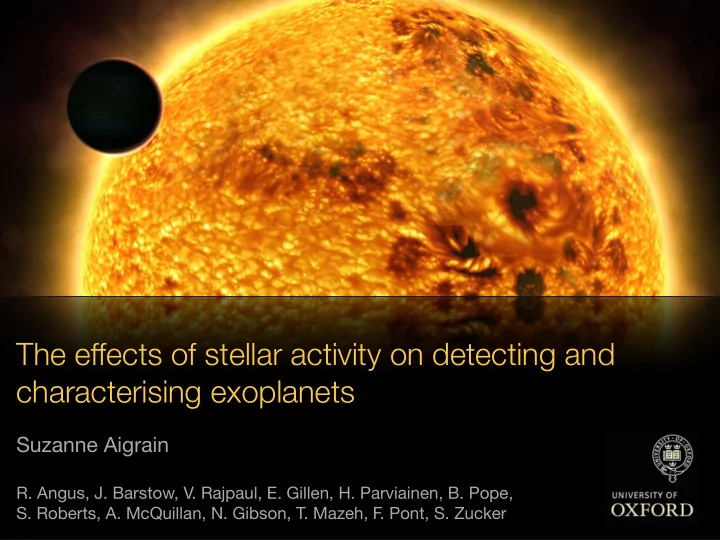

The effects of stellar activity on detecting and characterising exoplanets Suzanne Aigrain R. Angus, J. Barstow, V. Rajpaul, E. Gillen, H. Parviainen, B. Pope, S. Roberts, A. McQuillan, N. Gibson, T. Mazeh, F . Pont, S. Zucker
Timescales Solar irradiance (SoHO/VIRGO) Transits are easy to separate from photometric variations due to star spots Active regions … up to a point! Activity-induced variability is more problematic for: - transmission spectroscopy - radial velocity planet searches - phase curve studies Granulation Orbit Transits Oscillations (Aigrain, Favata & Gilmore 2004)
Filtering activity to detect transits Iterative non-linear filter followed by least-squares box-shaped transit search (Aigrain & Irwin 2004) P ~ 20h, depth 0.0003, R planet ~ 2 R Earth (CoRoT-7b, Leger et al. 2009)
When does activity matter for transit searches? Transit SNR = sqrt(N transits ) x depth / sigma(T transit ) where: - N transits is number of transits Intrinsic stellar variability on 6 hour time- - T transit is duration of transit scales from Kepler (Gilliland et al. 2011) Activity means Kepler would have needed 7 rather than 4 years to reach SNR of 10 for Earth-like planets in the Sun habitable zone of Sun-like stars This can be addressed, at least partially, by modelling the activity-induced variations simultaneously with the transits
Modelling stellar signals and instrumental systematics jointly using Gaussian Processes (GPs) Model activity as a quasi-periodic a Gaussian process. Example from K2 Campaign 7 Simultaneously model pointing-related systematics K2SC pipeline - Aigrain et al. 2016. Code and LCs available - talk to Hannu Parviainen First planet candidate catalog: Pope et al. (2016, on arXiv this week)
Activity in transit spectra • In any kind of high precision transit studies, need to worry about spots (see e.g. Pont et al. 2013): • occulted: distort transit, or make it seem shallower • un-occulted: make transit appear deeper • Both effects are very important and hard to correct for transmission spectroscopy • even in the IR (see e.g. Barstow et al. 2015 - JWST) • Plages may also be important (low contrast but large area) - Oshagh et al. (2014)
Spectroscopic effects of star spots Contrast between 5000 K photosphere and cool spots with different temperatures (MARCS models, Gustafsson et al. 2008, log g = 4.5, [Fe/H] = 0) TiO / VO T spot = 3500 K H 2 O Mg T spot = 4750 K Na
Accounting for spots in transmission spectra Estimate spectrum/temperature of spots from occulted spots HD189733b, Sing et al. (2012) T spot ~ 4250K - unique way to measure spot temperatures on other stars!
Accounting for spots in transmission spectra Estimate spectrum/temperature of spots from occulted spots - only possible in visible Estimate overall spot coverage from out-of-transit variability - only lower limit Estimate spot coverage of transit chord from rate of HD189733 (Pont et al. 2013) occulted spots - only catch the big ones In best cases, can estimate uncertainties due to spots, but not really correct for them Getting entire spectrum in one go helps! cf. EChO/Ariel/Twinkle projects See Barstow et al. (2015) for study of impact on JWST transmission spectroscopy
RV effects of activity - 1: distortion of rotation profile Line shape flux spot-free photosphere spot combined wavelength or velocity
RV effects of activity - 2: convective blueshift suppression Line shape inter-granular lanes upwelling straighter bisector granules flux magnetized region line core generated (plage) above photosphere smaller net blue-shift 0 (star rest frame) wavelength or velocity This dominates over the effect of spots for the Sun (Meunier et al. 2010)
Linking stellar photometric and RV variations Perturbation to full disk measurement due to one spot Can show that: flux equatorial spot Δ V rot ∝ ! Δ F × d( Δ F)/dt high latitude spot Δ V conv ∝ ! Δ F 2 (Aigrain, Pont & Zucker 2012) RV Limitations: - photometry (almost) insensitive to faculae - some active region configurations have no photometric signals, but do have RV signals - we do not always have simultaneous photometry
Rajpaul, Aigrain et al. (2015) see poster 23 Even with only spectra..
Transit survey light curves give 1000’s of rotation periods Largest ever catalog of stellar rotation periods (McQuillan, Mazeh & Aigrain 2014)
Clusters! Fantastic results in Pleiades, Upper Sco, Praesepe, Hyades (Rebull, Douglas, Covey…) M67 - R. Esselstein (poster 106), see also J. Weingrill (poster 28) test anomalous breaking in old blue stars ??? (van Saders et al. 2015)
Spot-crossing posters @ CS19: Hebb (330), Southworth (148) Spot mapping by transits also Gustavsson (134) - convection vs limb angle Spots occulted during multiple transits can be used to derive projected spin-orbit angle (Sanchis-Ojeda et al. 2011) HAT-P-11 Normalised Flux + Offset Normalised Flux + Offset E = 3 E = 15 1.000 1.000 E = 4 E = 16 0.996 0.996 0.992 0.992 -0.10 0.00 0.05 0.10 -0.10 0.00 0.05 0.10 -0.05 -0.05 Time from mid-transit (days) Time from mid-transit (days) NB: low-SNR spot-crossings can go un-detected but still bias measured time of transit This can be important for transit timing variation studies
Summary • Activity remains a major noise source for • detection of the shallowest, longest period planetary transits • detailed transit studies • phase curves • radial velocity detection / follow-up • Joint modelling of activity, instrumental noise & planet signal is more robust than attempting to filter one e ff ect to get at the other(s) • also more sensitive? should be, but remains to be shown in practice. • Exoplanet datasets are goldmine for activity studies • Want to get away from activity altogether? • eclipses, direct imaging & spectroscopy, astrometry, microlensing…
Recommend
More recommend